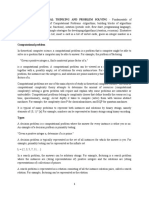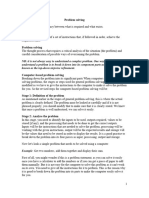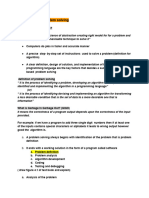problem solving process
Uploaded by
shortiemcleanproblem solving process
Uploaded by
shortiemcleanThe Problem Solving Process
A computer program is a finite set of precise instructions written in a programming language.
The design of a computer program involves:
The Problem-Solving Phase
The Implementation Phase
The Problem Solving Phase
1.Define the problem
2.Analyse the problem
3.Find a solution to the problem
4.Evaluate alternate solutions
5.Represent the most efficient solution as an algorithm
6.Test the correctness of algorithm
1. Define the problem
In defining the problem there must be no ambiguity. The objectives of the problem must be
specified: output, input, processing and in some cases the storage.
2. Analyse the problem
In this stage, you need to identify the inputs to be used, outputs required, processing that needs to
be done and values to be stored (if any). Input is the data needed to solve the problem, the
processing instructions manipulate the input data (e.g. mathematical operations, selecting
instructions) and the output instructions allow information to be displayed to the screen.
2
The Defining Diagram/Input-Processing-Output (IPO) Chart
This is a table with columns representing the input, output and processing activities required to
solve the problem.
Example: Write the steps to read a number, find its square and print the square of a number.
1. Identify Input: (number)
[keywords: read, input, accept, given]
2. Identify Process: (read number, calculate the square, print the square)
[What must I do with the inputs to produce the desired output?]
3. Identify Output: (print the square of the number)
[key words: print, display, output, produce]
IPO
Input Processing Output
Number eg num Read num sq
sq num * num
Print sq
Dr. Gill: Problem Solving Notes
3
3. Find a solution to the problem
Example: Read a number, find its square and print the square of the number.
Initial Solution
Get the number, store the number in a variable called num
Square the number by multiply the number by itself
Place the result of the square into a variable called sq
Print sq
Important Terms:
Variable: The name given to a temporary storage location for data used in a program.
When a new value is placed into a variable, the previous value is replaced by the new
one.
Variable names should reflect the kind of data being stored.
E.g. Sum = x+y and not Square = x+y.
Variable names should begin with an alphabetic character.
Initialization of variables: Variables that are used as counters or used to store totals
should always be assigned an initial value of 0 before they are incremented.
Constant: Represents a memory location where a fixed item of data are stored. Eg VAT =
17.5%
Dr. Gill: Problem Solving Notes
4
4. Evaluate alternate solutions
Points to consider:
1. Can you derive the result differently?
2. Can you make the solution more general?
3. Can you use the solution to solve another problem?
4. Can you reduce the number of steps and still maintain the logic?
5. Can you make the solution more robust? Would it work properly if incorrect data were
entered?
5. Represent the most efficient solution as an algorithm
The most efficient solution does not only mean the solution which results in the best use of
memory, or the shortest solution. The most efficient solution should be:
maintainable
memory efficient
robust
Algorithm: A sequence of instructions which represent the solution to a problem in a finite
number of steps.
NB. Algorithms may be expressed as narrative, pseudocode or flowcharts .
Features of algorithms: They must be:
Correct: Accept all inputs (even invalid inputs) and output a correct answer or
meaningful message.
Clear: The algorithm should be easy to read and understand.
Easy to implement: Translation to a programming language should be easy.
Dr. Gill: Problem Solving Notes
5
Efficient: The algorithm should facilitate a program which executes quickly.
Finite: There must be an end point for the algorithm.
6. Test the correctness of algorithm
Trace Tables:
A table in which you write the values of the variables in your algorithm. Test data are used to
check each statement of the algorithm to see if the algorithm is producing the correct results.
Dry Run
num sq Output
5 25 25
Important Terms:
Dry Run: A manual traversal of the logic and correctness of a program.
Testing: The process of checking the logic and correctness of a program.
Test Data: Dummy data used to check the logic and correctness of a program before end-
users operate it.
Live Data: Data previously processed by the system, that is used to check the logic and
correctness of a program before end-users operate it.
Program Trace: A software traversal of the logic and correctness of a program.
Dr. Gill: Problem Solving Notes
You might also like
- Hourglass Workout Program by Luisagiuliet 276% (21)Hourglass Workout Program by Luisagiuliet 251 pages
- The Hold Me Tight Workbook - Dr. Sue Johnson100% (16)The Hold Me Tight Workbook - Dr. Sue Johnson187 pages
- Read People Like A Book by Patrick King-Edited62% (66)Read People Like A Book by Patrick King-Edited12 pages
- Livingood, Blake - Livingood Daily Your 21-Day Guide To Experience Real Health77% (13)Livingood, Blake - Livingood Daily Your 21-Day Guide To Experience Real Health260 pages
- COSMIC CONSCIOUSNESS OF HUMANITY - PROBLEMS OF NEW COSMOGONY (V.P.Kaznacheev,. Л. V. Trofimov.)94% (212)COSMIC CONSCIOUSNESS OF HUMANITY - PROBLEMS OF NEW COSMOGONY (V.P.Kaznacheev,. Л. V. Trofimov.)212 pages
- Donald Trump & Jeffrey Epstein Rape Lawsuit and Affidavits83% (1016)Donald Trump & Jeffrey Epstein Rape Lawsuit and Affidavits13 pages
- The 36 Questions That Lead To Love - The New York Times94% (34)The 36 Questions That Lead To Love - The New York Times3 pages
- The 36 Questions That Lead To Love - The New York Times95% (21)The 36 Questions That Lead To Love - The New York Times3 pages
- Jeffrey Epstein39s Little Black Book Unredacted PDF75% (12)Jeffrey Epstein39s Little Black Book Unredacted PDF95 pages
- The 4 Hour Workweek, Expanded and Updated by Timothy Ferriss - Excerpt23% (954)The 4 Hour Workweek, Expanded and Updated by Timothy Ferriss - Excerpt38 pages
- Ge3151 Problem Solving and Python Programming92% (12)Ge3151 Problem Solving and Python Programming35 pages
- Problem Solving in Everyday Life:: P1: Solve the equation ax+b=0, where a,b ε RNo ratings yetProblem Solving in Everyday Life:: P1: Solve the equation ax+b=0, where a,b ε R13 pages
- CSEC IT Notes - Term 1 Week 9 - Problem Solving and Programming Lecture 2No ratings yetCSEC IT Notes - Term 1 Week 9 - Problem Solving and Programming Lecture 247 pages
- Topic 8 - Problem Solving Concepts - Part 1_6b2a94f5cd20d4bce408735a58f95cd2No ratings yetTopic 8 - Problem Solving Concepts - Part 1_6b2a94f5cd20d4bce408735a58f95cd222 pages
- Introduction To Problem Solving Techniques: StructureNo ratings yetIntroduction To Problem Solving Techniques: Structure14 pages
- GE8151 Problem Solving and Python Programming - 03 - by LearnEngineering - inNo ratings yetGE8151 Problem Solving and Python Programming - 03 - by LearnEngineering - in100 pages
- CLASS 11 CS CH3_INTRODUCTION TO PROBLEM SOLVING_NOTESNo ratings yetCLASS 11 CS CH3_INTRODUCTION TO PROBLEM SOLVING_NOTES11 pages
- Improved Detection Network Model Based On YOLOv5 For Warning Safety in Construction SitesNo ratings yetImproved Detection Network Model Based On YOLOv5 For Warning Safety in Construction Sites12 pages
- Report On Health Care Chatbot Using AI PDFNo ratings yetReport On Health Care Chatbot Using AI PDF9 pages
- What Is A Charts?: Practical Work 6 MS Excel. Spreadsheets&modellingNo ratings yetWhat Is A Charts?: Practical Work 6 MS Excel. Spreadsheets&modelling2 pages
- Lab Test 2 (25 Marks) : Coding Time: 1 Hour and 30 MinsNo ratings yetLab Test 2 (25 Marks) : Coding Time: 1 Hour and 30 Mins8 pages
- Andromeda Series Filter User's Manual PDFNo ratings yetAndromeda Series Filter User's Manual PDF34 pages
- Int J Communication - 2020 - Swain - A Cost Effective LoRa Based Customized Device For Agriculture Field Monitoring andNo ratings yetInt J Communication - 2020 - Swain - A Cost Effective LoRa Based Customized Device For Agriculture Field Monitoring and21 pages
- eScan-Company-Profile-Technology NemasisNo ratings yeteScan-Company-Profile-Technology Nemasis5 pages
- Learn Visual Basic Version 6: Part 2: The Two Button Form in DetailNo ratings yetLearn Visual Basic Version 6: Part 2: The Two Button Form in Detail6 pages
- Turning Off Auto-Sync Data in Gmail AppsNo ratings yetTurning Off Auto-Sync Data in Gmail Apps3 pages
- Fpga Implementation of Modified Radix 2 SRT Division AlgorithmNo ratings yetFpga Implementation of Modified Radix 2 SRT Division Algorithm4 pages
- Intelligent System Concept of An IoT Cameras Network Application For An Unmanned Aerial Vehicle Control Via A Graphical User InterfaceNo ratings yetIntelligent System Concept of An IoT Cameras Network Application For An Unmanned Aerial Vehicle Control Via A Graphical User Interface4 pages
- Siti Nabila Binti Mohamad Fauzi (51213116029)No ratings yetSiti Nabila Binti Mohamad Fauzi (51213116029)95 pages
- Webdevelopment in Pharmacy Management 37 FullNo ratings yetWebdevelopment in Pharmacy Management 37 Full39 pages
- TopDev - High Performance and Scalability Database Design - V2.1No ratings yetTopDev - High Performance and Scalability Database Design - V2.152 pages
- Zebradesigner Essentials Version 3 User Guide: Product Level: Essentials. Rev-2019-1 P1108968-EnNo ratings yetZebradesigner Essentials Version 3 User Guide: Product Level: Essentials. Rev-2019-1 P1108968-En138 pages
- Computer (Hindi) One-Liner Delhi Police HCM - RBENo ratings yetComputer (Hindi) One-Liner Delhi Police HCM - RBE19 pages
- Senior Assistant 5th Level AdministrationNo ratings yetSenior Assistant 5th Level Administration9 pages
- (BIG DATA) (MapReduce - Quick Guide, Tutorialspoint - Com)No ratings yet(BIG DATA) (MapReduce - Quick Guide, Tutorialspoint - Com)36 pages
- Livingood, Blake - Livingood Daily Your 21-Day Guide To Experience Real HealthLivingood, Blake - Livingood Daily Your 21-Day Guide To Experience Real Health
- COSMIC CONSCIOUSNESS OF HUMANITY - PROBLEMS OF NEW COSMOGONY (V.P.Kaznacheev,. Л. V. Trofimov.)COSMIC CONSCIOUSNESS OF HUMANITY - PROBLEMS OF NEW COSMOGONY (V.P.Kaznacheev,. Л. V. Trofimov.)
- Donald Trump & Jeffrey Epstein Rape Lawsuit and AffidavitsDonald Trump & Jeffrey Epstein Rape Lawsuit and Affidavits
- The 36 Questions That Lead To Love - The New York TimesThe 36 Questions That Lead To Love - The New York Times
- The 36 Questions That Lead To Love - The New York TimesThe 36 Questions That Lead To Love - The New York Times
- Jeffrey Epstein39s Little Black Book Unredacted PDFJeffrey Epstein39s Little Black Book Unredacted PDF
- The 4 Hour Workweek, Expanded and Updated by Timothy Ferriss - ExcerptThe 4 Hour Workweek, Expanded and Updated by Timothy Ferriss - Excerpt
- Practical Design of Experiments: DoE Made EasyFrom EverandPractical Design of Experiments: DoE Made Easy
- Problem Solving in Everyday Life:: P1: Solve the equation ax+b=0, where a,b ε RProblem Solving in Everyday Life:: P1: Solve the equation ax+b=0, where a,b ε R
- CSEC IT Notes - Term 1 Week 9 - Problem Solving and Programming Lecture 2CSEC IT Notes - Term 1 Week 9 - Problem Solving and Programming Lecture 2
- Topic 8 - Problem Solving Concepts - Part 1_6b2a94f5cd20d4bce408735a58f95cd2Topic 8 - Problem Solving Concepts - Part 1_6b2a94f5cd20d4bce408735a58f95cd2
- Introduction To Problem Solving Techniques: StructureIntroduction To Problem Solving Techniques: Structure
- GE8151 Problem Solving and Python Programming - 03 - by LearnEngineering - inGE8151 Problem Solving and Python Programming - 03 - by LearnEngineering - in
- CLASS 11 CS CH3_INTRODUCTION TO PROBLEM SOLVING_NOTESCLASS 11 CS CH3_INTRODUCTION TO PROBLEM SOLVING_NOTES
- Improved Detection Network Model Based On YOLOv5 For Warning Safety in Construction SitesImproved Detection Network Model Based On YOLOv5 For Warning Safety in Construction Sites
- What Is A Charts?: Practical Work 6 MS Excel. Spreadsheets&modellingWhat Is A Charts?: Practical Work 6 MS Excel. Spreadsheets&modelling
- Lab Test 2 (25 Marks) : Coding Time: 1 Hour and 30 MinsLab Test 2 (25 Marks) : Coding Time: 1 Hour and 30 Mins
- Int J Communication - 2020 - Swain - A Cost Effective LoRa Based Customized Device For Agriculture Field Monitoring andInt J Communication - 2020 - Swain - A Cost Effective LoRa Based Customized Device For Agriculture Field Monitoring and
- Learn Visual Basic Version 6: Part 2: The Two Button Form in DetailLearn Visual Basic Version 6: Part 2: The Two Button Form in Detail
- Fpga Implementation of Modified Radix 2 SRT Division AlgorithmFpga Implementation of Modified Radix 2 SRT Division Algorithm
- Intelligent System Concept of An IoT Cameras Network Application For An Unmanned Aerial Vehicle Control Via A Graphical User InterfaceIntelligent System Concept of An IoT Cameras Network Application For An Unmanned Aerial Vehicle Control Via A Graphical User Interface
- TopDev - High Performance and Scalability Database Design - V2.1TopDev - High Performance and Scalability Database Design - V2.1
- Zebradesigner Essentials Version 3 User Guide: Product Level: Essentials. Rev-2019-1 P1108968-EnZebradesigner Essentials Version 3 User Guide: Product Level: Essentials. Rev-2019-1 P1108968-En
- (BIG DATA) (MapReduce - Quick Guide, Tutorialspoint - Com)(BIG DATA) (MapReduce - Quick Guide, Tutorialspoint - Com)























































































































